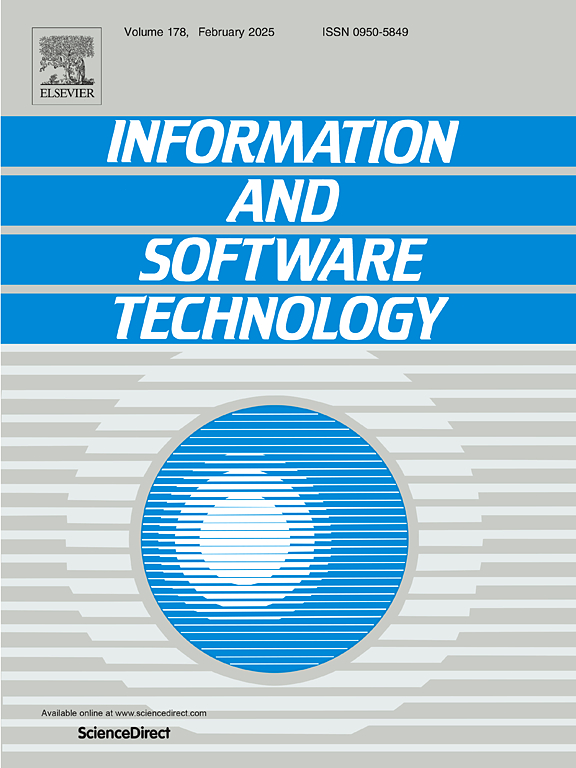A study of Scrum @ S&P Global in the post-COVID-19 era: Unsuitable for remote work or just flawed implementation?
IF 4.3
2区 计算机科学
Q2 COMPUTER SCIENCE, INFORMATION SYSTEMS
引用次数: 0
Abstract
Context:
Although the COVID-19 pandemic is behind us, the seminal challenge for agile teams has not gone away, as “Work-From-Home (WFH) is here to stay”. Despite a wealth of literature documenting the challenges of applying agile methods in remote environments, practical guidance for overcoming these challenges remains limited. Furthermore, systematic meta-guidelines to help practitioners develop tailored, context-specific solutions are largely absent.
Method:
This article reports on an Action Research project conducted at S&P Global 18 months after the company’s transition to a WFH model.
Objective:
The project aimed to evaluate existing adaptations to remote work, identify persistent issues, and develop strategies to address them.
Results:
Our investigation revealed that while ad-hoc solutions — such as virtualizing Scrum ceremonies and shifting informal in-person conversations to Slack channels — enabled work continuity during the pandemic, they proved insufficient for tackling more complex challenges. Intriguingly, only two ongoing issues stemmed from misalignments between Scrum and remote settings, while the remainder were rooted in flawed Scrum implementation. With our guidance, the participating team not only rediscovered the “Inspect and Adapt” principle but also mastered a systematic approach to method tailoring, enabling them to devise measures that effectively resolved most of their issues.
Conclusion:
Our study reinforces prior findings indicating the applicability of Scrum beyond its traditional “home ground”, while also highlighting the need for remote teams to exhibit even greater discipline in adhering to the Scrum framework to navigate the additional challenges of remote work. We also observed a heightened necessity for more comprehensive documentation in remote settings to compensate for limited immediate access to colleague assistance, which consequently restricts knowledge sharing. Finally, the structured approach we employed offers valuable guidance for software companies seeking to identify and address operational inefficiencies in both remote and hybrid work environments.
后covid -19时代对标准普尔全球Scrum的研究:不适合远程工作还是只是有缺陷的实施?
背景:尽管2019冠状病毒病大流行已经过去,但敏捷团队面临的重大挑战并没有消失,因为“在家工作”(WFH)将继续存在。尽管有大量文献记录了在远程环境中应用敏捷方法的挑战,但克服这些挑战的实用指导仍然有限。此外,系统的元指南,以帮助从业者开发量身定制的,具体情况的解决方案,在很大程度上是缺乏的。方法:本文报告了在标准普尔全球公司过渡到WFH模式18个月后进行的一项行动研究项目。目标:该项目旨在评估对远程工作的现有适应,确定持续存在的问题,并制定解决这些问题的策略。结果:我们的调查显示,虽然临时解决方案(如虚拟化Scrum仪式和将非正式的面对面对话转移到Slack渠道)在疫情期间实现了工作连续性,但事实证明,它们不足以应对更复杂的挑战。有趣的是,只有两个持续的问题源于Scrum和远程设置之间的不一致,而其余的问题则源于Scrum实施的缺陷。在我们的指导下,参与团队不仅重新发现了“检查和适应”原则,而且掌握了系统的方法裁剪方法,使他们能够设计出有效解决大部分问题的措施。结论:我们的研究强化了之前的发现,表明Scrum在其传统“主场”之外的适用性,同时也强调了远程团队在坚持Scrum框架以应对远程工作的额外挑战方面需要表现出更大的纪律。我们还观察到,在远程环境中,需要更全面的文档,以弥补即时获得同事协助的限制,从而限制了知识共享。最后,我们采用的结构化方法为寻求识别和处理远程和混合工作环境中操作效率低下的软件公司提供了有价值的指导。
本文章由计算机程序翻译,如有差异,请以英文原文为准。
求助全文
约1分钟内获得全文
求助全文
来源期刊

Information and Software Technology
工程技术-计算机:软件工程
CiteScore
9.10
自引率
7.70%
发文量
164
审稿时长
9.6 weeks
期刊介绍:
Information and Software Technology is the international archival journal focusing on research and experience that contributes to the improvement of software development practices. The journal''s scope includes methods and techniques to better engineer software and manage its development. Articles submitted for review should have a clear component of software engineering or address ways to improve the engineering and management of software development. Areas covered by the journal include:
• Software management, quality and metrics,
• Software processes,
• Software architecture, modelling, specification, design and programming
• Functional and non-functional software requirements
• Software testing and verification & validation
• Empirical studies of all aspects of engineering and managing software development
Short Communications is a new section dedicated to short papers addressing new ideas, controversial opinions, "Negative" results and much more. Read the Guide for authors for more information.
The journal encourages and welcomes submissions of systematic literature studies (reviews and maps) within the scope of the journal. Information and Software Technology is the premiere outlet for systematic literature studies in software engineering.
 求助内容:
求助内容: 应助结果提醒方式:
应助结果提醒方式:


